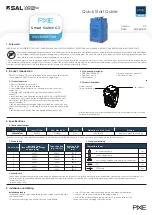
Detecting and Managing Faults
13
Note –
The most recent events are listed at the top of the log.
In this example, Event ID
18567
on September 18, at 15:51, indicated that a critical
fault occurred in the component with Oracle ILOM target
/SYS/PSU0
. This is
power supply 0 as identified in
“Clearable Fault Targets” on page 11
. Following
the Oracle ILOM target is the reason for the fault. A URL is provided for more
information about the fault.
Moving up the output, Event ID
18569
on September 18, at 16:43, indicated that a
repair action was taken on the component with Oracle ILOM target
/SYS/PSU0
.
The power supply was
repaired
. The term
repaired
can mean either repaired
or replaced. In either case, the power supply in slot 0 was now functional.
Continuing up the output, Event ID
18820
on September 25 indicated that a
critical fault occurred again in the component with Oracle ILOM target
/SYS/PSU0
.
4. Depending on the severity of the fault, replace the component.
See
“Clearable Fault Targets” on page 11
for servicing links.
Related Information
■
“Interpreting Status LEDs” on page 1
■
“Managing Faulty Components” on page 7
■
“Determining the Alarm State of a Component or System” on page 13
■
“Evaluating Sensor Alarms” on page 17
■
“Accessing CLI Prompts” on page 34
Determining the Alarm State of a
Component or System
When a component or system of components experiences a condition which triggers
an alarm, the condition might affect the operation of the gateway. These topics enable
you to display alarm states.
■
“Display the General Alarm State of Systems and Components” on page 14
to http://support.oracle.com/msg/DCSIB-8000-23 for details.
.
.
.
->
















































